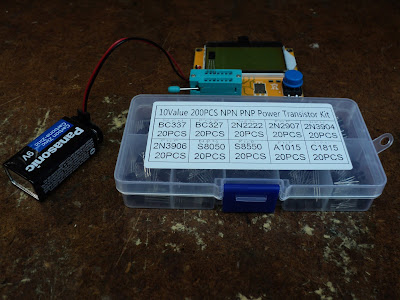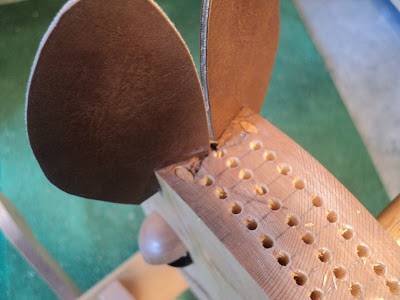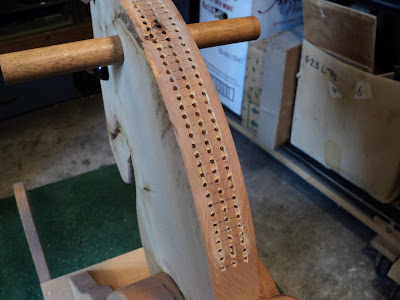I've become a grandfather. So, I guess that a rocking horse is in order. At the rate that I work, I should have it done by about the time that my granddaughter is ready for it.
I purchased a U-BILD rocking horse plan from Lee Valley.
As is par for the course with all such DIY material, the rocking horse is allegedly 'easy' to construct; ("...appropriate for any skill level...", as Lee Valley's blurb puts it.) On the plan's jacket, seen in the above photo, it says, "Easy Plan! Just Trace, Saw and Assemble." Yeah, right. I've studied the plan, and I'm calling hogwash on all that. The plan looks frightfully challenging to me -- fraught with perils and difficulties.
[1] Had I not committed to making the thing, I'd take a pass on it and file the plan away under 'maybe, but unlikely'.
Anyway, I've embarked on the venture, and here's where I'm at so far.
I joined the head and torso with four No. 20 biscuits. The plan calls for the use of two 3/8" dowels. I find dowel joinery to be problematic at the best of times, so I opted for biscuits. That worked out fairly well.
Next up is to cut the body to shape on the bandsaw, and sand the cut edges.
- - -
And here it is done.
And this is as good a place as any for a little digression on tooling for this project. There's a
lot of curve sawing and edge sanding involved. The plan would have you do the sawing with a portable sabre saw (jig saw), and I call hogwash on that -- a band saw is called for.
Band Sawing & Belt Sanding
I don't have a full-size band saw, nor do I have a great deal of band sawing experience. What I do have is one of these little 9" band saws from Canadian Tire.
As toy machinery goes, it's not a bad unit, and I've been reasonably well pleased with its performance.
The saw takes a 62" blade, and the only such blade that's locally available, either from Canadian Tire or Home Depot, is 1/4" wide, 6 tpi. 6 tpi is a pretty coarse blade that leaves a rough cut edge. You have to cut well to the waste side of a line to be sure of being able to sand away all the saw scarring without going beyond your line.
In the interest of obtaining a smoother cut, I ordered a 1/4" wide, 14 tpi blade from Amazon and tried it out. The 14 tpi blade does cut quite smoothly, but there's a downside -- the blade's teeth have very little set, so the blade is disinclined to cut curves. For straight cuts or very large radius curves it's ok, but on curves of any tightness it's inclined to bind. Amazon has a 1/8" wide, 14 tpi blade that would no doubt cut curves nicely, but a 1/8" wide band saw blade would surely be a fragile item, prone to breakage. So, I'm back to sawing with a 6 tpi blade, which at least has sufficient set that it negotiates curves easily. I just have to resign myself to doing a lot of belt sanding to remove the saw scarring from the cut edges. And that brings me to my Ridgid oscillating edge belt/spindle sander.

It's quite a piece of gear, and it works as advertised. I consider it to be a 'must have' for this project. I bought 50 grit belts for it for dealing with my rough, band sawn edges. The 80 grit belt that comes with the machine produces an acceptable finished edge. 120 grit belts can be had, if one wanted even more finely sanded edges.
Anyway, there's what I consider to be essential tooling for one to tackle this rocking horse.
A Bit More Progress
Here's one front leg cut to shape and edge-sanded with a 50 grit belt.
An 80 grit edge-sanding is still to be done.
And my band saw blade dulled and broke, so a trip to Home Depot is in order to get a replacement.
- - -
Legs Sawn Out --
SATURDAY, APRIL 21, 2018
A heap of belt sanding lies ahead. It's a good thing I got those 50 grit belts for the Ridgid machine. I also got 120 grit belts, as I decided I wasn't quite happy with the finish I was getting with an 80 grit belt.
- - -
Leg Wedges --
WEDNESDAY, APRIL 25, 2018
I've done a final sanding of all four legs' edges with a 120 grit belt. The edges aren't quite perfect, but they'll do.
And now comes a trial -- fabricating a set of wedges that will splay the legs out at a 7° angle from the body. I have a taper cutting jig for my tablesaw, but it doesn't really lend itself to cutting pointed wedges, as must be done here. So, I'm going to do a quick-and-dirty here; I'll simply lay out the wedge components on 2" nominal stock, and cut them freehand on the bandsaw. Here's a view of the layout for eighteen wedge pieces.
I haven't made allowance for saw kerf width in my layout, so my wedges are going to turn out a little bit undersize. I think there's enough wiggle room to the final assembly that that shouldn't really matter.
And here are eighteen wedge pieces cut out.
They're pretty rough, but they're going to have to do one way or another. The next step is to glue up individual wedge pieces into four broad wedges that will go where the legs join the body. This may be the absolute worst part of the entire construction. I wish there were a better way.
- - -
Front Leg Wedges Done --
TUESDAY, MAY 1, 2018
For each front leg, five of the wedge elements are glued together edge-to-edge to make a wide enough wedge. Then those broad wedges are glued to the inboard upper ends of the legs, like so.
The glued-up/glued-on wedges then get band sawn and belt sanded to the contours of the legs.
It's Recognizable, At Least --
TUESDAY, MAY 22, 2018
The rocker has a nice action to it. Getting the legs positioned and fitted to the body was an ordeal. The plan would have you do it with the aid of the pattern, but I couldn't see making that work. I resorted to 'by-guess-and-by-gosh' methods.
Here's a view of the horse with some further progress made. The stirrups and the handlebar are in place.
There's still much to be done.
- - -
Done --
SUNDAY, JUNE 24, 2018
There it is, quite the shaggy beast.
I'll eventually follow up on all this with some notes and observations on the plan and its execution. 'Easy' it was not.
- - -
Notes And Observations --
WEDNESDAY, JUNE 27, 2018
Feet To Feet-Platforms Interface
The plan would have you saw or belt sand the 'feet' so they sit flat on their platforms. As you can see from the above photo, I didn't even try to do that; I consider it virtually impossible to perform such a procedure and get it right. Each foot is securely fastened to its platform by two #8 x 2" round head wood screws, with flat washers under the heads. I don't believe that the strength of those joins is much impaired by their not being flattened.
Screw Counterbore Plugs
Incredibly, the plan calls for using dowel for screw counterbore plugs. That simply is not the done thing. Dowel plugs present end grain to the surface. They won't sand down properly, and they will stand out prominently and look awful when stained. Screw counterbore plugs are cut across the grain from waste material with a plug cutter, like
these from Lee Valley. The plugs are aligned on installation so that their face grain lines up with the grain of the surrounding wood. They're readily trimmed down to near flush with a chisel, then sanded to be perfectly flush.
Leg Wedges Shaping
The plan calls for the lower ends of the leg wedges to be contoured so they align with the contours of the body. I couldn't see a way to do that successfully, so I didn't even try. I left the lower ends of the leg wedges squared off and protruding, like so.
The effect on overall appearance of the horse is not objectionable.
Saddle And Stirrups
By sheer dumb luck, I had on hand some cedar material suitable for making the saddle and stirrups. Using that made for a nice, realistic contrast to the lighter colour of the SPF (Spruce Pine Fir) horse.
Eyes
I found the plan's instructions for making the eyes to be a bit difficult to fathom, but I finally managed to understand them. Lee Valley carries
wooden spheres of the correct size for making the eyes from.
Sawing up spheres into sections is not easy, but I managed to do it to good effect. The eyeballs I primed with Tremclad grey primer, and painted with one coat of Tremclad gloss black.
Rounding The Edges
The plan's instructions for rounding the edges of the horse's body, head and legs to a 1/2" radius struck me as utter nonsense; I wouldn't attempt such a method. I did the edge rounding with a 3/16" radius round-over bit in a palm router. The 3/16" radius is adequate to my eye, and much easier to execute than a 1/2" radius, which I think is excessive.
Ears
The plan calls for leather ears. The best I could come up with was some suitably coloured pleather cut from a discarded handbag. I laminated two thicknesses of it together with clear silicone sealant as an adhesive, to create ear material with two good sides. The finished thickness of my ear material was just over 3/32".
The ears are set in saw kerfs. The trick there is to find a saw that yields a kerf width that matches one's ear material thickness. It turned out that my wife's pruning saw from the garden shed fit the bill. I glued the ears in place in their saw kerfs with CA adhesive, and added 1/8" dowel pins at a shallow angle as a further security measure. Here's a view of that, such as it is.
The upshot of all that is that the ears are problematical -- they're not an easy detail to execute well.
- - -
Yarn For The Mane And Tail
I went to Michael's in Pickering to look over their yarns, and found this.
The colour is taupe (a brownish grey). A single 86 yard skein was sufficient for the mane and tail.
- - -
The Tail
I didn't get quite as full a tail as the plan's author appears to have. I found it very difficult to adhere to the plan's instructions for making the tail. Anyway, the tail I came up with is acceptable.
The Mane
I found the plan's instructions for laying out the mane to be questionable. The plan would have you lay out a closely spaced diagonal grid for a fantastic number of holes in which to insert yarn lengths. I settled on a rectangular grid of three holes across, which eliminated a baldness down the centre, and gave me an acceptable mane.
That's about 150 holes that have to have yarn plugged into them -- a very tedious undertaking. The result is well worth the effort.
In Conclusion
The plan, however one is able to follow it, produces a wonderful rocking horse. The design is brilliant -- way ahead of anything I've seen that can be had store-bought.
That said, many aspects of the plan are iffy and questionable. The rocking horse is not an easy thing to make. You're in for the woodworking challenge of your life should you decide to tackle it.
* * *
Note:
[1] I'd love to hear from anyone who's built one of these rocking horses, who'd care to share with me how their experience of it went.
# # #
# # #

























































